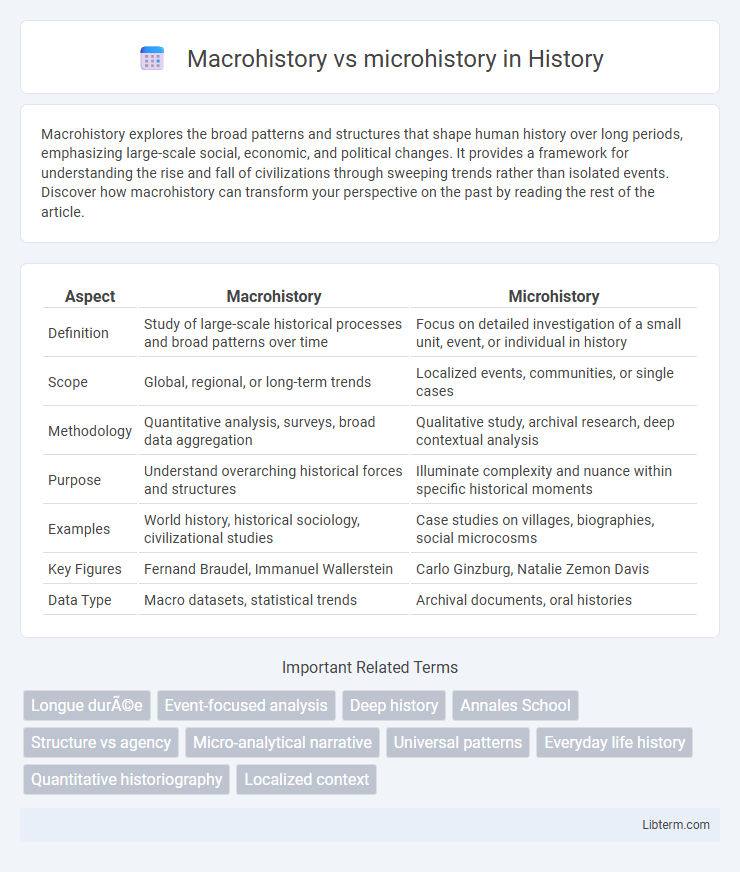Macrohistory explores the broad patterns and structures that shape human history over long periods, emphasizing large-scale social, economic, and political changes. It provides a framework for understanding the rise and fall of civilizations through sweeping trends rather than isolated events. Discover how macrohistory can transform your perspective on the past by reading the rest of the article.
Table of Comparison
| Aspect | Macrohistory | Microhistory |
|---|---|---|
| Definition | Study of large-scale historical processes and broad patterns over time | Focus on detailed investigation of a small unit, event, or individual in history |
| Scope | Global, regional, or long-term trends | Localized events, communities, or single cases |
| Methodology | Quantitative analysis, surveys, broad data aggregation | Qualitative study, archival research, deep contextual analysis |
| Purpose | Understand overarching historical forces and structures | Illuminate complexity and nuance within specific historical moments |
| Examples | World history, historical sociology, civilizational studies | Case studies on villages, biographies, social microcosms |
| Key Figures | Fernand Braudel, Immanuel Wallerstein | Carlo Ginzburg, Natalie Zemon Davis |
| Data Type | Macro datasets, statistical trends | Archival documents, oral histories |
Understanding Macrohistory: Big Picture Analysis
Macrohistory examines large-scale historical processes and patterns over extensive periods, analyzing economic systems, social structures, and political ideologies that shape civilizations. This approach utilizes comparative data to identify long-term trends and global connections, offering insights into the evolution of societies beyond individual events. By focusing on broad themes like migration, technological change, and cultural diffusion, macrohistory provides a comprehensive framework for understanding historical dynamics at a systemic level.
Exploring Microhistory: Focused Narratives
Microhistory centers on deeply detailed studies of specific events, individuals, or communities, revealing broader social and cultural dynamics through focused narratives. This approach uncovers the complexities of everyday life and challenges grand historical generalizations by highlighting unique, localized experiences. By prioritizing granular detail, microhistory provides rich insights into historical processes often overlooked by macrohistorical frameworks.
Key Differences Between Macrohistory and Microhistory
Macrohistory analyzes broad patterns and large-scale processes across extensive periods, emphasizing societal, economic, and political transformations on a global or regional level. Microhistory focuses on detailed investigations of individual events, communities, or people, highlighting the nuances and complexities often overlooked by larger narratives. The key differences lie in scale, scope, and methodology: macrohistory employs quantitative data and theoretical frameworks, while microhistory relies on qualitative evidence and narrative storytelling.
Methodologies in Macrohistorical Research
Macrohistorical research employs large-scale quantitative data analysis, comparative historical methods, and longue duree perspectives to identify broad patterns across centuries or civilizations. It integrates interdisciplinary tools such as big data analytics, computational modeling, and global systems theory to trace structural changes and long-term social transformations. Emphasis on aggregating macro-level variables contrasts with microhistory's focus on detailed narrative and individual case studies.
Techniques Used in Microhistorical Studies
Microhistorical studies employ techniques such as detailed archival research, oral history interviews, and analysis of material culture to reconstruct specific events or individuals' lives with granular precision. These approaches prioritize close examination of localized contexts, contrasting with macrohistory's broad, thematic analysis of large-scale social, economic, or political trends. Microhistory's emphasis on particularity reveals the complexity and diversity often masked in overarching historical narratives.
Benefits of Macrohistorical Perspectives
Macrohistorical perspectives enable the analysis of large-scale social, economic, and political processes across extended time periods, revealing long-term trends and patterns that shape civilizations. This approach facilitates the understanding of broad historical forces such as globalization, empire dynamics, and systemic change that microhistory might overlook. By integrating extensive datasets and comparative methods, macrohistory provides context for individual events within wider structural frameworks, enhancing the depth of historical interpretation.
Insights Gained from Microhistorical Approaches
Microhistorical approaches provide detailed insights into individual experiences and specific events, revealing social, cultural, and everyday life dynamics often overlooked in macrohistory. By focusing on localized contexts and personal narratives, microhistory uncovers nuanced power relations, mentalities, and behaviors that enrich our understanding of broader historical processes. This method challenges generalizations and emphasizes complexity, highlighting the diversity and contingency inherent in historical developments.
Famous Examples of Macrohistory in Practice
Famous examples of macrohistory include Fernand Braudel's analysis of the Mediterranean world during the 16th century, which emphasizes long-term social, economic, and geographic structures over individual events. Another key example is Jared Diamond's "Guns, Germs, and Steel," exploring broad patterns of human development and environmental factors shaping civilizations. These works highlight the significance of large-scale processes and structural forces in understanding historical change.
Notable Case Studies in Microhistory
Microhistory emphasizes detailed investigations of specific individuals or small communities to reveal broader historical truths, with notable case studies including Carlo Ginzburg's analysis of the 16th-century miller Menocchio, which challenged dominant narratives about popular culture and beliefs in early modern Europe. Another key example is Natalie Zemon Davis's work "The Return of Martin Guerre," which explores identity, justice, and social norms in 16th-century France through a localized legal case. These studies highlight microhistory's power to uncover complexities overlooked by traditional macrohistorical approaches focused on large-scale events and trends.
Integrating Macrohistory and Microhistory for Deeper Insights
Integrating macrohistory and microhistory provides deeper insights by combining broad historical patterns with detailed individual experiences, enriching the understanding of complex social dynamics over time. Macrohistory offers large-scale perspectives on civilizations, economies, and cultural shifts, while microhistory focuses on local events, personal narratives, and specific communities. This interdisciplinary approach enables historians to contextualize personal stories within grander historical processes, enhancing analytical depth and nuance.
Macrohistory Infographic

 libterm.com
libterm.com